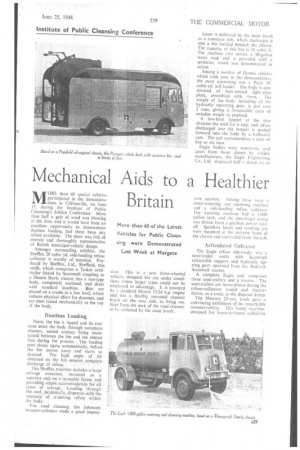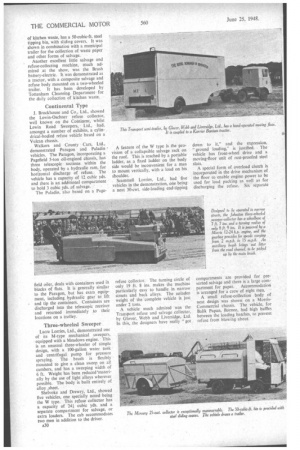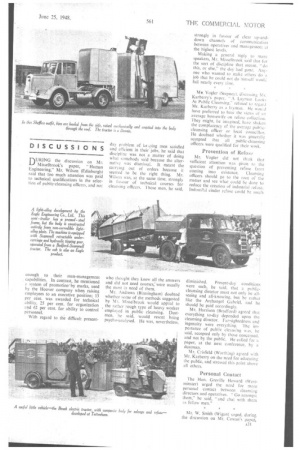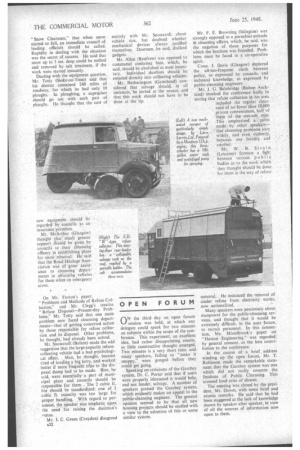Aids to a Healthier Britain
Page 31

Page 32

Page 33

Page 34

If you've noticed an error in this article please click here to report it so we can fix it.
own account. Among these were a street-watering and cleansing machine and a side-loading refuse collector. The watering machine had a 1.000gallon tank, and the centrifugal pump was driven from a gearbox po+. er takeoff. Sprinkler heads and washing jets were mounted at the extreme front of the chassis and controlled from the cab.
Articulated Colketor
The Eagle refuse side-loader was a semi-trailer outfit with Scarnmell retractable support and hydraulic tipping gear, operated front [he BedfordScammell tractor.
A complete Eagle unit comprises three semi-trailers and a tractor. The semi-trailers arc horse-drawn during the refuse-collection round and tract ordrawn, as a train, to the disposal dump.
The Mercury 25-cwt. truck gave a convincing exhibition of its remarkable manceuvrability. This handy machine, designed for house-to-house collection of kitchen waste, has a 50-cubic-ft. steel tipping bin, with sliding covers. It was shown in combination with a municipal trailer for the collection of waste paper and other forms of salvage.
Another excellent little salvage and refuse-collecting machine, much admired at the show, was the Brush battery-electric. It was demonstrated as a tractor, with a composite salvage and refuse body mounted on a two-wheeled trailer. It has been developed by Tottenham Cleansing Department for the daily collection of kitchen waste.
Continental Type
J. Brockhouse and Co., Ltd., showed the Lewin-Oschner refuse collector, well known on the Continent, whilst Lewin Road Sweepers, Ltd., had, amongst a number of exhibits, a cylindrical-bodied refuse vehicle based on a Vulcan chassis.
Walkers and County Cars, Ltd., demonstrated Paragon and Paladin vehicles. The Paragon, incorporating a Pagefield 5-ton oil-engined chassis, has three telescopic sections within the body, operated by a hydraulic ram, for horizontal discharge of refuse. The vehicle has a capacity of 12 cubic yds. and there is an additional compartment to hold 3 cubic yds. ,of salvage.. . The Paladin, also based on a Page
field oiler, deals with containers used in blocks of flats. It is generally similar to the Paragon, but has extra equipment, including hydraulic gearto lift and tip the containers. Containers are discharged into the telescopic receiver and returned immediately to their locations on a trolley.
Three-wheeled Sweeper
Lacre Lorries, Ltd., demonstrated one of its M-type mechanical sweepers, equipped with a Meadows engine. This is an unusual three-wheeler of simple design, with a 100-gallon water tank and centrifugal pump for pressure spraying. The brush is flexibly mounted tO give a clean sweep on all cambers, and has a sweeping width of 6 ft. Weight has been reduced•materially by the use of light alloys wherever possible. The body is built entirely of alloy sheet.
Shelvoke and Drewry, Ltd., showed five vehicles, one specially noted being the W type. This refuse collector has a capacity of 241 cubic yds. and a separate compartment for salvage, or extra loaders. The cab accommodates two men in addition to the driver.
A30 A feature of the W type is the provision of a collapsible salvage rack on the roof. This is reached by a portable ladder, as a fixed ladder on the body side would be inconvenient for a man to mount vertically, with a load on his shoulder.
Scammell Lorries, Ltd., had five vehicles in the demonstration, one being a neat 30-cwt. side-loading end-tipping refuse collector. The turning circle of only 19 ft. 8 ins, makes the machine particularly easy to handle in narrow streets and back alleys. The unladen weight of the 'complete vehicle is just under 2 tons.
A vehicle much admired was the Transport refuse and salvage collector, by Glover, Webb and Liversidge, Ltd. In this, the designers have really got down• to it," and the expression, "ground loading," is justified. The vehicle has front-wheel drive and a moving-floor unit of rust-proofed steel slats.
A special form of overload clutch is incorporated in the drive mechanism of the floor to enable engine power to be used for load packing as well as for discharging the refuse. Six separate compartments are provided for presorted salvage and there is a large compartment for paper. Accommodation is arranged for a crew of eight men. • A small refuse-collection body of neat design was shown on a MorrisCommercial chassis. The vehicle, for Batik Papan, Borneo, had high baffles between the loading hatches, to prevent refuse from blowing about.
nUR1NG the discussion on Mr.
Misselbrook's paper, "Human Engineering," Mr. Wilson (Edinburgh) said that too much attention was paid to technical qualifications in the selection of public-cleansing officers, and not enough to their man-management capabilities. In contrast, he mentioned e system of promotioniby marks, used by the Hoover company when raising employees to an executive position; 13 per cent. was awarded for technical ability, 25 per cent, for organization and 62 per cent. for ability to control personnel.
With regard to the difficult present
day problem of ke.....)ing men satisfied and efficient in their jobs, he said that discipline was not a matter of doing what somebody said because the alternative was dismissal. It meant the carrying out of orders because it seemed to be the right thing. Mr. Wilson was, at the same time, strongly in favour of technical courses for cleansing officers, Those men, he said, who thought they knew all the answers and did not need courses, were usually the most in need of them.
. Mr. Andrews (Birmingham) doubted whether some of the methods suggested by Mr. Misselbrook would appeal to the rather rough type of heavy worker employed in public cleansing. Dustmen, he said, would resent being psycho-analysed. He was, nevertheless, strongly in favour of clear up-anddown channels of communication between operatives and management at the highest levels.
Making a general reply to many speakers, Mr. Misselbrook said that for the sort of discipline that meant. "do this, or else," the day had gone. Anyone who wanted to make others do a job that he could not do himself \wok; fail nearly every time.
MA Vogler (Stepney), discussing M r. Karberry's paper, " A Layman Looks At Public Cleansing," refused to repel Mr. Karherry as a layman. HQ would have preferred to hear the views of in average housewife on refuse collection. They might, he imagined, have shaken the complacency of the average pubccleansing officer or local councillor. He doubted whether it was generally accepted that all public-cleansing officers were qualified for their work.
Prevention of Refuso
Mr. Vogler did not think that sufficient attention was given 10 the question of preventing refuse from coming into existence, Cleansing officers should go to the root of the matter and see what could be done to reduce the creation of industrial refuse. Induste%al cinder refuse could he much diminished. Present-day conditions were such, he said, that a publiccleansing director must not only be ailseeing and all-knowing, but be rather like the Archangel Gabriel. and he should be paid accordingly, Mr. Harrison (Bradford) agreed that everything to-day depended upon the cleansing director. Far-sightedness and ingenuity were everything, The importance of public cleans*, was, he said, accepted only by those concerned. and not by the public. He called for a paper, at the next conference, by a dustman.
Mr. Crisfield (Worthing) agreed with Mr. Karberry on the need for educating the public, and stressed this point above all others.
Personal Contact
The Hon. Greville Howard (Westminster) urged the need for more personal contact between cleansing directors and operatives. " Go amongst them." he said, "and chat with them as fellow men." •
"Snow Clearance," that when snow started to fall, an immediate council of leading officials should be called. Rapidity in dealing with the situation was the secret of success. He said that snow up to 5 ins, deep could be melted and• removed by salt treatment, if the work were started instantly.
Dealing with the equipment question, Mr. Totty (Stoke-on-Trent) said that his district contained 240 miles of roadway, for which he had only 10 ploughs. In ploughing, a superwisor should go out with each pair of ploughs. He thought that the cost of "Problems and Methods of Refuse Collection," and Mr. Clegg's treatise " Refuse Disposal—Present-day Problems," Mr. Totty said that one main problem now faced cleansing departments—that of getting concerted action by those responsible for refuse collection and its disposal. Other problems, he thought, had already been solved.
Mr. Snowcroft (Bolton) made the odd suggestion that the large-capacity refusecollecting vehicle had a bad psychological effect. Men, he thought, became tired of loading a big lorry, and worked better if more frequent trips to the disposal dump had to be made. Bins, he said, were essentially a part of municipal plant and councils should be responsible for them. The 2 cubic ft. bin should be standardized; one of 3 cubic ft. capacity was too large for proper handling. . With regard to personnel, the speaker was emphatic upon the need for raising the dustman's status.
Mr. J. C. Green (Croydon) disagreed A32 entirely with Mr. Snowcroft about vehicle size, but doubted whether mechanical devices always justified themselves. Dustmen, he said, disliked gadgets.
Mr. Allen (Renfrew) was opposed to communal container bins, which, he said, should be abolished as most insanitary. Individual dustbins should be emptied directly into collecting vehicles.
Mr. Hetherington (Gateshead) considered that salvage should, in all instances, be sorted at the source, and that this work should not have to be done at the tip.
ON the third day an open forum session was held, at which any delegate could speak for two minutes on subjects within the scope of the conference. This experiment, an excellent idea, had rather disappointing results, as little constructive thought emerged. Two minutes is a very short time, and many speakers, failing to "make it snappy," were ganged before they could get going.
Speaking on criticisms of the Garchey system, Dr. C. Porter said that if users were properly instructed it would help, and not hinder, salvage. A number of speakers praised the Garchey system, which evidently makes an appeal to the public-cleansing engineer. The general opinion seemed to be -that all new housing projects should be studied with a view to the adoption of this or some similar system. Mr. F. E. Browning (Islington) was strongly opposed to a parochial attitude in cleansing affairs, which, he said, was the negation of those purposes for which the Institute was founded. Problems must be faced in a co-operative spirit.
Couti. J. Davis (Glasgow) deplored the all-too-frequent clash between policy, as expressed by councils, and technical knowledge, as expressed by public-cleansing engineers.
Mr. J. G. Bainbridge (Bishop Auck land) shocked the conference badly in stating that refuse collection in his area included the regular clearance of no fewer than 10,000 private conveniences, half of
new ram& them of the Wet-ash tYpe. eeper of This emphasized a point
•
made by other speakers= that cleansing problems vary widely, and even violently, between one locality and another.
Mr. W.' B. Strain. (Leicester) foresaw a fight between various public bodies as to the work which they thought should be done for them in the way of refuse
removal. He instanced the removal of cinder refuse from electricity works, now nationalized.
Many speakers were pessimistic about manpower for the public-cleansing services, and thought that it would be extremely difficult, in the near future, to recruit personnel. In this connection. Mr. Misselbrook's paper on "Human Engineering" was regarded, by general consent, as the best contribution to the conference.
In the course of a brief, address winding up the open forum, Mr. T. Robinson made the remarkable statement that the Garchey system was one which did not really concern the Institute of Public Cleansing. This aroused loud cries of dissent.
The meeting was closed by the president, Mr. Dawes, with some brief and caustic remarks. He said that he had been staggered at the lack of knowledge shown by speaker after speaker, in view of all the sources of information now open to them.












































































